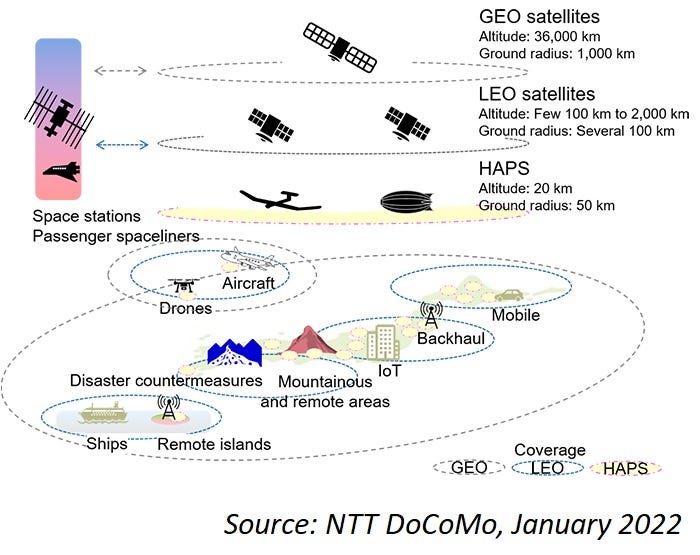NTT hopes to succeed where Google Loon and Facebook Aquila failedNTT hopes to succeed where Google Loon and Facebook Aquila failed
Offering connectivity from balloons and drones is proving a tough nut to crack, but NTT has lined up some partners that it hopes will deliver a breakthrough.
January 17, 2022

Offering connectivity from balloons and drones is proving a tough nut to crack, but NTT has lined up some partners that it hopes will deliver a breakthrough.
The Japanese telco has teamed up with its mobile arm DoCoMo, aircraft maker Airbus and Japanese satcoms provider Sky Perfect JSAT Corporation to conduct a feasibility study on high altitude platform stations (HAPS). Deployed at altitudes of around 20 kilometres, they are essentially flying base stations that can provide coverage to a radius of around 50 kilometres.
A statement issued by DoCoMo said the study, which falls under a memorandum of understanding (MoU) between the aforementioned companies, will combine Airbus’s solar-powered drone – called Zephyr – with the networks of NTT, DoCoMo and Sky Perfect JSAT in order to “test HAPS connectivity, identify practical applications, develop required technologies and ultimately launch space-based wireless broadband services.”
According to NTT and its partners, HAPS networks represent a fairly easy means of offering connectivity to aircraft and ships, and providing connectivity to areas hit by natural disasters. Their vision is that HAPS could eventually form part of a telco’s broader non-terrestrial networking (NTN) portfolio, which would also include things like geostationary and low-Earth orbit (LEO) satellites.

“With the signing of the MOU, the four companies will discuss and identify possible future developments necessary to unlock future HAPS-based connectivity services, lobby for standardisation and institutionalisation of HAPS operations, and explore business models for commercialising HAPS services,” said DoCoMo.
“Specific themes will include the applicability of HAPS for mobile connectivity on the ground and base station backhaul, the performance of various frequency bands in HAPS systems, the technological considerations for linking HAPS with satellites and ground base stations, and the establishment of a cooperative system to test a network combining NTN technology, satellites and HAPS,” the telco said.
If the group achieves its stated objectives, it will have succeeded where a few other big names have failed.
Google, which has a long and rich history of dabbling, had a go at HAPS in 2011. Project Loon as it was called, consisted of a fleet of stratospheric balloons with base stations dangling beneath them. It was spun out of Google’s ‘X’ lab into a standalone company in 2018 and launched its first commercial service in partnership with Telkom Kenya in 2020. However, Project Loon couldn’t drive the costs down low enough to turn it into a viable long-term business, and the whole enterprise ceased operations around this time last year. Alongside Project Loon, Google also flirted with drone-based connectivity. This one was called Project Titan, and it fared even worse than Loon. Test flights began in 2015, but amid rumours of funding issues and technical difficulties, the whole thing was canned in early 2016.
Meta or Facebook or whatever you want to call it also had a crack at HAPS. As part of its effort to connect the unconnected and sell their data to advertisers, in 2016 it showed off Aquila: a portable fleet of unmanned, solar-powered drones that would deliver service to rural areas. It gave up on the idea two years later after reaching the not-so-startling conclusion that it wasn’t particularly good at building aircraft.
Despite these high-profile failures, the aviation and telecoms industries are clearly not ready to give up on HAPS just yet. They even launched their own lobby group in February 2020, the HAPS Alliance. Last month it announced the successful test flight of Sunglider, an unmanned, solar-powered aircraft equipped with an LTE base station. Funnily enough, Airbus, DoCoMo and Sky Perfect JSAT are all members of the HAPS Alliance, which aims to create an ecosystem around the technology that will turn it into a sustainable business.
DoCoMo et al are undoubtedly aware of the unproven business case for this technology, and so spreading the risk across several experts – rather than going it alone like Google and Facebook – is probably better than the HAPS-hazard approach taken by those giants of Silicon Valley.
About the Author
You May Also Like










.png?width=300&auto=webp&quality=80&disable=upscale)


_1.jpg?width=300&auto=webp&quality=80&disable=upscale)